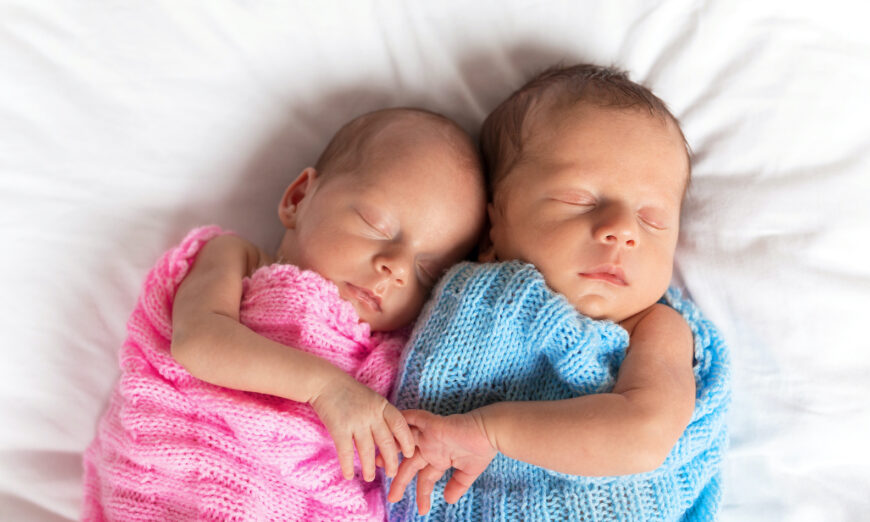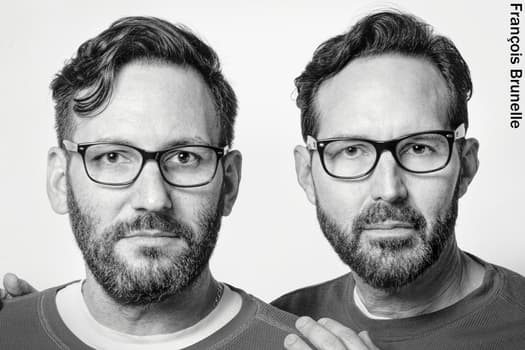
While twinning may not equal winning for some fraternal girl twins, the upsides to being a twin remain. (Patryk Kosmider/Shutterstock)
Since the early 1980s the number of twins born in the United States has risen by 60 percent. From the parents’ point of view, that may mean getting two for the price of one (hooray!) or signing on for double trouble (ut oh).
Still, whether twin parents are delighted or terrified, scientific research suggests that moms of twins live longer than moms of singletons. The reasons are not clear—it may be that women who birth twins are healthier to begin with or that having twins, like having children later in life, confers a longer life span. Whatever the reason, it’s nice to know that running around after your dynamic duo may sabotage your sanity but won’t shave years off your life.
But what about from the twins’ point of view?
While it may be wonderful to have a constant companion, built-in best friend, and someone to blame for the window you just broke, scientifically speaking there appear to be both advantages and disadvantages to being born a twin.
A Longer Life Span?
Research from a Danish database published in 2016 found that identical twins and fraternal twins both outlived their counterparts who were not twins. Interestingly, this twin longevity advantage was especially true for identical male twins.
For this study, scientists from the University of Washington in Seattle found that identical twins had a survival advantage over fraternal twins. But being a twin of any ilk resulted in several extra years of life.
The scientists examined data on nearly 3,000 same-gender twin pairs who were born at the turn of the 20th century (between 1870 and 1900).
The scientists found that the twins’ average life spans were up to five years longer than the average in Denmark at that time.
The researchers called this observed increased longevity a “twin protective effect.”
While the reasons twins may live longer than their non-twin counterparts are not entirely clear, scientists have speculated that it may be because of the strong social bonds between twins.
Having a sibling the same age, for instance, might keep you from engaging in risky behaviors, while also providing you with emotional, practical, and even financial support.
This 2016 study was limited by the small sample size and the fact that the twins were born over a hundred years ago in a country with midwife-led birthing practices. In addition, at the turn of the century, the vast majority of twins were born vaginally in every country in the world.
The Bane of Abdominal Birth
Since the mid to late 1960s, however, more American twins started to be delivered abdominally. Between 1995 and 2008 cesarean delivery rates for twins increased dramatically, from 53 percent to 75 percent, according to a 2011 analysis published in the journal Obstetrics and Gynecology.
This is bad news for babies, as hundreds of scientific studies now link cesarean birth to poor health outcomes later in life.
For example, a 2015 article published in the British Medical Journal found that children delivered via C-section have higher incidences of type 1 juvenile diabetes, obesity, and asthma. All of these conditions are associated with decreased quality of life and shorter life spans.
Lower Life Outcomes
Besides the complications that come from cesarean birth, there may be another health disadvantage to being a twin—for a girl twin sharing her mother’s womb with a brother anyway.
Consider this: a 2019 study published in the journal the Proceedings of the National Academy of Sciences found that female twins who are exposed to male hormones in the womb suffer negative impacts later in life.
The study found that baby girls who are exposed in utero to a male twin may not fare as well when it comes to education, salary, and fertility.
This was a large longitudinal study. The scientists examined the outcomes of more than 13,700 Norwegian twins born between 1967 and 1978. They found that females exposed to higher levels of male hormones in the womb due to being conceived with a male twin had what they called lower life outcomes than female twins who gestated with another female twin.
Indeed, girls who gestated with boys had a lower likelihood of graduating from high school or university. They also had fewer children, and earned less money as young adults than girls who gestated with girls.
A Pre- or Post-Natal Problem?
The study’s lead author, Dr. Krzysztof Karbownik, earned his Ph.D. in economics at Uppsala University in Sweden and is currently an assistant professor of economics at Emory University in Atlanta, Georgia.
After finding this negative impact on girl twins who gestated with boys, Karbownik and his team of scientists wanted to determine whether the differences seen in the female twins’ life outcomes were due to growing up with a brother of the same age—or if they were the result of something that happened in utero.
To answer this question, the researchers studied another group of twins. These were girls who were separated and raised apart from their male twin brothers.
Hormonally Charged: The Twin Testosterone-Transfer Hypothesis
It turned out that the negative effects on life outcomes were still present for girl twins, even when the girls were not raised with their twin brothers.
This suggests that the differences seen in the female twins’ life outcomes were the result of what is called the “twin testosterone transfer hypothesis.”
This hypothesis posits that male hormones are transferred from the male twin to the female twin during pregnancy.
While the data is mixed, animal studies have also found that females that share a litter with males differ from females born in all-female litters. This supports the idea that exposure to male hormones in utero can have subtle but potentially deleterious effects on female twin development.
The 2019 study was the first of its kind to track twins for more than 30 years, following them from birth to adulthood. Though the differences in outcomes were not large, they were statistically significant, according to the researchers.
Other previous studies have also found a potential negative effect for twin girls who shared a womb with a brother.
For example, a 2007 study using the health records of Finland found that girls with twin brothers were 25 percent less likely to have children and 15 percent less likely to marry if their twin was male. This team of British and Finnish researchers suspected that what they called “hormonal interactions,” that is, exposure in the womb to testosterone, damaged the female twins’ fertility.
Seeing Double
These days something like 1.6 million twins are born each year, which means one in every 42 babies born is a twin, according to WebMD.
In one southwestern city in Nigeria, West Africa, nearly every family has twins or even triplets.
In fact, there are so many twins in Igbo-Ora that the city hosts an annual festival to celebrate them.
At this year’s celebration, over a thousand pairs of twins were in attendance, according to NPR. No one is sure, but locals think the reason for the high numbers of twins may be partly because women’s diets are high in amala, a dish made from white yams, which are a staple among the Yoruba in Nigeria.
Worldwide, the number of twins appears to be increasing due to more couples using in vitro fertilization and other assisted reproductive technologies.
Should these families with twins and expectant couples be concerned? Probably not.
While twinning may not equal winning for some fraternal girl twins, the upsides to being a twin remain. Besides, females who gestate with boy twins may have advantages in other aspects of their lives that were not measured by the 2019 study. As the scientists explained, “it may be that females gestating with male co-twins excel in other domains of life that we are unable to measure in our data.” In addition, they concluded, changing social norms and cultural mores may also turn some perceived disadvantages into advantages over time.






